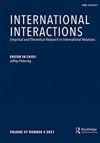使用状态空间模型预测政治暴力
IF 1.4
3区 社会学
Q2 INTERNATIONAL RELATIONS
引用次数: 4
摘要
我们提供了一种新的状态空间建模方法的概念验证,用于预测每月因政治暴力导致的死亡人数。人们的注意力集中在开发方法和展示这种方法的实用性上,这为与领域专家合作开发新的和改进的状态空间模型来预测暴力提供了令人兴奋的机会。预测是在空间分辨率为0.5 × 0.5度的细胞网格上进行的,每个细胞都被建模为具有两个数学上定义良好的未观察/潜在/隐藏状态,这些状态随着时间的推移而演变,并分别编码“发病风险”和“潜在严重程度”。这为模型提供了一定程度的可解释性。通过使用该模型计算未来时间死亡人数的概率分布,该概率分布以截至当前时间的所有观测数据为条件,从而获得预测分布。预测分布通常在死亡人数为0(没有暴力爆发)处放置一定的质量,如果出现暴力爆发,则剩余的质量指示死亡人数的可能间隔。为了评估模型性能,我们(缺乏更好的替代方法)报告预测分布的平均值,但是访问预测分布本身就是对应用程序的一个有趣的贡献。这项工作只是作为这类数据的状态空间建模方法的概念验证,并提出了几个可能的进一步工作方向,可以提高预测性能。本文章由计算机程序翻译,如有差异,请以英文原文为准。
Predicting political violence using a state-space model
Abstract We provide a proof-of-concept for a novel state-space modelling approach for predicting monthly deaths due to political violence. Attention is focused on developing the method and demonstrating the utility of this approach, which provides exciting opportunities to engage with domain experts in developing new and improved state-space models for predicting violence. The prediction is made on a grid of cells with spatial resolution of 0.5 × 0.5 degrees, and each cell is modeled to have two mathematically well-defined unobserved/latent/hidden states that evolves over time and encode the “onset risk” and “potential severity”, respectively. This offers a certain level of interpretability of the model. By using the model for computing the probability distribution for a death count at a future time conditioned on all data observed up until the current time, a predictive distribution is obtained. The predictive distribution typically places a certain mass at the death count 0 (no violent outbreak) and the remaining mass indicating a likely interval of the fatality count, should a violent outbreak appear. To evaluate the model performance we—lacking a better alternative—report the mean of the predictive distribution, but the access to the predictive distribution is in itself an interesting contribution to the application. This work merely serves as a proof-of-concept for the state-space modeling approach for this type of data and several possible directions for further work that could improve the predictive performance are suggested.
求助全文
通过发布文献求助,成功后即可免费获取论文全文。
去求助
来源期刊

International Interactions
INTERNATIONAL RELATIONS-
CiteScore
2.40
自引率
7.70%
发文量
38
期刊介绍:
International Interactions is a leading interdisciplinary journal that publishes original empirical, analytic, and theoretical studies of conflict and political economy. The journal has a particular interest in research that focuses upon the broad range of relations and interactions among the actors in the global system. Relevant topics include ethnic and religious conflict, interstate and intrastate conflict, conflict resolution, conflict management, economic development, regional integration, trade relations, institutions, globalization, terrorism, and geopolitical analyses.
 求助内容:
求助内容: 应助结果提醒方式:
应助结果提醒方式:


